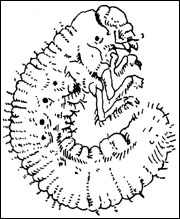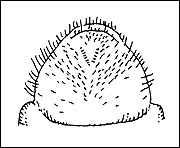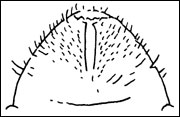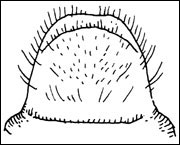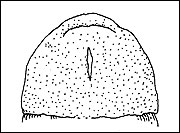Although insects are one of the most populous forms of animal life on earth, only a small number of them may, at some time, become a potential problem in turfgrass. Turfgrass insects can be somewhat cyclical and very dependent on a number of factors. Weather, suitable food sources, desirable habitat and predators all play a part in the population size of particular insect species.
Turfgrass damage is usually not observed until the numbers of an insect species reach a threshold level. For example, a homeowner does not need to treat a lawn with pesticides if only one or two white grubs are found while doing yardwork. However, if the homeowner peels back dead sod and finds more than five annual white grubs per square foot, treatment would be needed. Turfgrass-damaging insects may be present in a stand, but to warrant action, they need to be in a large enough population to cause decline.
Turfgrass pests cannot be controlled over long periods of time solely through the use of pesticides. To have healthy and vigorous turfgrass, it may be necessary to use pesticides in combination with sound cultural practices. A properly designed integrated pest management (IPM) system not only will maintain control of existing pests, but also will help prevent the recurrence of these pests and the possibility of new pest outbreaks.
Plan for potential pest problem before planting. Keep records of past problems at your site(s), and discuss pest problems with neighbors or colleagues.
A healthy, growing plant is the best defense against most insect pests. Many plants become more susceptible to pests if they are stressed. Following good turf management practices with mowing, proper watering, fertilization, aeration, thatch control and overall sanitation (e.g., removal of leaf litter or debris) produces good, healthy and dense turf.
Integrated pest management for insect control
Integrated pest management (IPM), the idea of integrating turf management cultural practices into a control program for turfgrass pests, is a concept that has been around for years. Efforts to start an IPM program begin with a discussion of basic plant health care.
More-detailed discussions about turfgrass species/cultivars, mowing, watering, fertility, aeration and thatch control are all part of this newer concept to put more emphasis on plant health care (PHC). Consider what can you do to develop the healthiest plant possible to combat or defend against weeds, diseases or insects.
IPM and PHC both still recognize the need for insecticides when all else fails. There are times when insect levels are just too great for even a healthy lawn to overcome. Turfgrass managers adopting IPM or PHC practices will have a better understanding of the environmental conditions that weeds, diseases and insects prefer.
When pest problems prevail, consider whether the turfgrass manager had done all that was culturally possible, and what changes might need to be made in the management program. Crucial decisions early in the development of a pest management program can make a significant difference in the direction a program takes.
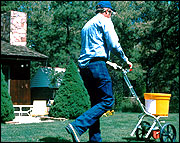 Integrated pest managment is a systematic approach to solving pest problems through cultural practices, with insecticide application being a legitimate tactic when all else fails. University of Arizona photo
Integrated pest managment is a systematic approach to solving pest problems through cultural practices, with insecticide application being a legitimate tactic when all else fails. University of Arizona photo
Turfgrass species and cultivars
If possible, select a species, cultivar or blend/mixture of turf that is best suited for the environmental conditions in which it will be grown. Turfgrasses adapted to Missouri's transitional climate are better able to withstand stress. Keep in mind, though, that no single turfgrass species will grow well here year-round.
However, several opportunities exist to select turfgrass species that offer insect resistance. Insects often prefer feeding on one turfgrass species over another, so selection of a species that is not a preferred food source for a prevalent insect pest will reduce potential for damage. Selection of endophyte-enhanced turfgrasses may also produce a healthy turfgrass stand with a reduced need for pesticide use. Endophytes are fungi (Neotyphodium spp.) that live within turfgrass plants. Endophyte-enhanced turfgrasses — perennial ryegrasses and tall fescues — resist insect damage by producing toxins called alkaloids. These alkaloids are not harmful to plants but deter insects that feed on them.
Mowing
Turfgrasses are placed under constant stress when they are mowed lower than their proper height. Scalping reduces plant vigor and reduces overall root growth, making the plant more susceptible to other environmental stresses and pests.
Keep turfgrasses mowed at the recommended height for the species, never remove more than one-third of the leaf blade at one time, and always keep mower blades sharp. Cool-season turfgrasses should be maintained at 3 inches or higher, whereas warm-season grasses may be maintained at 1 to 2 inches. Proper mowing practices will make a lawn more tolerant of insect damage.
Watering
Irrigation may be a vital part in the development of a healthy lawn; however, watering could have some drawbacks when insects are involved. Beetles of many root-feeding insects prefer moist soil to lay eggs. Egg-laying females seek out moist soils to lay eggs because the survival of their larvae, which are white grubs, is dependent on moisture.
Allowing turfgrasses to dry out slightly during the peak flight period, from late May to early June, may help to reduce the potential for white grub damage in late July to early August.
Good irrigation practices will help turfgrasses recuperate in late summer and early fall. Sound irrigation practices also encourage a vigorous root system and therefore healthier top-growth. Maintaining a healthy turf may help mask damage caused by insects such as billbugs or sod webworms.
When irrigating, avoid puddles and runoff. Most clay soils in Missouri have an infiltration rate of about ¼ inch per hour. Audit the output of your irrigation system by placing small cans at various spots in your lawn and measuring water depth with a ruler after a certain amount of run time. Simply match the output of your irrigation system to the infiltration rate of your soil. Your irrigation system may only need to run 20 minutes to equal the infiltration rate of your soil type. Applying more water than the soil can absorb is a waste.
Fertility
Soil testing is the best start in developing a good fertility program. Avoiding excessive nitrogen applications will keep plants from becoming too succulent and therefore more susceptible to insect damage. Excessive fertilizer applications can also lead to significant thatch buildup, creating a good habitat for chinch bugs, billbugs and sod webworms. Follow local recommendations for a balanced fertility program to provide good shoot and root growth and recovery from light to moderate insect damage.
Aeration
Soil aeration can greatly improve the quality of turfgrasses. Aeration reduces soil compaction and allows air, water and nutrients to more readily enter the turfgrass root zone. Sustaining a quality root-zone environment increases the quality of shoots and leaf tissue several times over. When done at the proper times of the year, aeration will also make for more efficient use of irrigation and fertilizer applications.
The two most prevalent types of aeration are solid tine and hollow tine. Solid tine aerators simply punch into the soil profile. Hollow tine aerators physically remove plugs of soil, a process called core aeration. Soil removed by core aeration may be added into the thatch layer, thus increasing the population of soil microbes present to break down organic matter and thatch. Thatch reduction will discourage some insects from inhabiting the turfgrass stand.
Thatch
Thatch is the layer of partly decayed plant material (i.e., stems and roots) and organic matter between the growing turf and the soil. Excessive thatch acts as a sponge for water and nutrients, making them unavailable to the plant. Thatch also acts as a perfect habitat for insects to lay eggs, develop and populate a turfgrass stand.
Thatch can be controlled in several ways:
- Core aeration physically removes thatch and brings soil microbes to the surface to break down organic matter.
- Light top-dressings with topsoil similarly may result in thatch reduction by incorporating thatch-degrading soil microbes and providing them habitat.
- An active earthworm population also provides some decomposition of organic matter and thatch.
- Mechanical removal of the thatch layer can be done with a dethatching or vertical-slicing machine. These machines can be rented at a local hardware or equipment-rental store. Set the depth of the blades just low enough to catch the soil surface. With the blades at this depth, the thatch layer will be partially removed and soil will be incorporated into the remainder.
- Good plant health care practices are the key to developing a vigorous turfgrass stand. A healthy lawn can withstand two to three times the normal insect threshold for economic damage and offer a quick recovery when damage does occur.
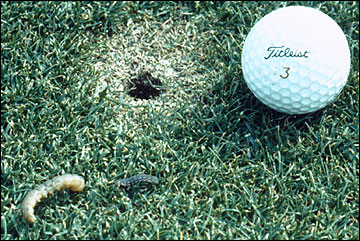 Cutworms feed on turfgrass crowns, which produces thinned, tan-colored spots around tunnel entries. Birds on golf greens usually indicate the presence of cutworms.
Cutworms feed on turfgrass crowns, which produces thinned, tan-colored spots around tunnel entries. Birds on golf greens usually indicate the presence of cutworms.
 Greenbug aphid damage on a tall fescue home lawn. Lee Miller photo.
Greenbug aphid damage on a tall fescue home lawn. Lee Miller photo.
Insect anatomy
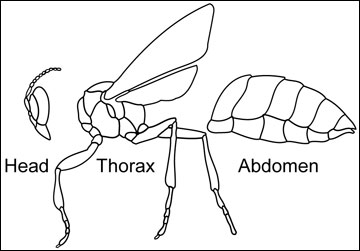 All adult insects have two physical characteristics in common. They have three pairs of jointed legs and three body regions: a head, thorax and abdomen.
All adult insects have two physical characteristics in common. They have three pairs of jointed legs and three body regions: a head, thorax and abdomen.
Head
The head has antennae, eyes and mouthparts. Antennae vary in size and shape and can be helpful in identifying some pest insects. Antennae are movable and contain sensory receptors that are used to detect odors, tastes, vibrations and other stimuli. Insects have compound eyes composed of many facets, each with its own lens. Compound eyes enable insects to detect motion but probably do not produce clear images.
Most insects also have one to three simple eyes, or ocelli, located on the upper part of the forehead. These simple eyes do not see images, but they are sensitive to changes in light intensity that may trigger a reaction of flight or running.
The four general types of insect mouthparts are chewing, piercing-sucking, sponging and siphoning. Chewing mouthparts contain toothed jaws that bite and tear. Beetles, caterpillars (larvae of Lepidoptera, including armyworms, cutworms and sod webworm) and grasshoppers are in this group.
Piercing-sucking mouthparts consist of a long, slender tube that is forced into plant tissue to suck out juices or sap. Insects with these mouthparts include chinch bugs, greenbug aphids and spittlebugs. Mites, which are not insects, also have piercing-sucking mouthparts.
Sponging mouthparts are tubular tonguelike structures with a spongy tip to suck up liquids or soluble food. This type of mouthpart is found in house flies. Siphoning mouthparts are formed into a long tube for sucking nectar. Butterflies and moths have this type of mouthpart.
Thorax
The thorax contains the three pairs of legs and, if present, the wings. The various sizes, shapes and textures of wings help identify insect species. The forewings take many forms. In beetles, they are hard and shell-like; in grasshoppers, they are leathery.
The forewings of flies are membranous; those of true bugs are part membranous and part hardened. Most insects have membranous hindwings. The wings of moths and butterflies are membranous but are covered with scales.
Abdomen
The abdomen is usually composed of 11 segments, but eight or fewer segments may be visible. Along each side of most of the segments are openings called spiracles, through which oxygen enters and carbon dioxide exits the internal respiratory system.
Near the end of the abdomen is an opening, the anus, through which waste passes from the insect's body. In some insects, the tip end of the abdomen has taillike appendages. It is on the abdomen of white grubs where raster, or hair, patterns identify one species of white grub from others.
Five steps to effective pest management practices
- Properly identify key pests and the damage they cause.
- Monitor pest populations regularly.
- Determine potential for economic loss from pest.
- Select the proper pest control tactic, such as cultural, biological or chemical.
- Evaluate the control measure used.
Note
When using any insecticide, read and follow directions on the label accompanying that product. Reference to specific trade names in this publication does not imply endorsement by the University of Missouri; discrimination is not intended against similar products not mentioned.
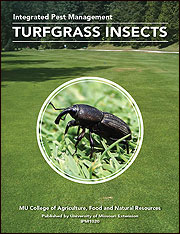 Bruce Barrett
Bruce Barrett